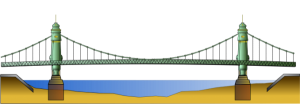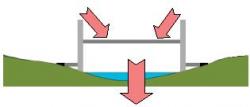Les Ponts Suspendus

Les ponts suspendus existent depuis presque aussi longtemps que les ponts en arc. Ils datent du Moyen-Âge, à l’époque on utilisant des lianes à la place de câbles en acier. C’est grâce a ces derniers qu’on peut construire des ponts suspendus de portée importante. Aujourd’hui la technologie a avancé, mais le principe reste le même : il faut maintenir le poids du tablier avec des câbles en acier solidement arrimés aux berges. Ces câbles sont étayés par des pylônes qui se trouvent à chaque coté d’une travée.
Ce type de pont permet de relier des longues distances mais il comporte de nombreux inconvénients : Premièrement, il faut quatre points d’encrage de poids importants pour pouvoir supporter la force exercée par les câbles. À cause de ce fait, il ne peut pas être construit n’importe où. De plus, pour une intervention lorsque on entretien ou remplace un des câbles, il faut entièrement fermer le pont à cause du danger. Finalement, il faut bien étudier sa prise au vent, or ce type de pont cède facilement face aux vents forts.

Etude de Cas : Le Golden Gate Bridge
Il n’existe probablement aucun pont plus reconnu que le « Pont du Golden Gate. » Aisément reconnaissable par sa couleur « orange international, » ce pont reste une icône non-seulement de San Francisco mais aussi des États-Unis.
Officiellement inauguré le 27 mai 1937, il a été construit en quatre ans, de 1933 à 1937. Malgré de nombreuses complications lors de sa construction, qui a coûté 35 millions de dollars, elle a réussi à battre de nombreux records mondiaux : celui des tours les plus hautes, des câbles les plus longs et des fondations les plus larges. De plus, le Golden Gate Bridge a également été le pont suspendu le plus long au monde jusqu’en 1964, mesurant 1966 mètres de long et 30 mètres de large. Il compte six voies de circulation ouvertes au trafic automobile et deux allées réservées aux piétons. Pour pouvoir résister aux vents de 160 Km/h, le pont peut se balancer de deux mètres de chaque coté. Finalement, ses deux tours culminent à quelques 230 mètres au dessus des eaux du détroit du Golden Gate. Chaque tour comporte approximativement 600 000 rivets. L’entretien du pont consiste à maintenir la couche de peinture iconique afin de le protéger contre le sel marin contenu dans l’air.












